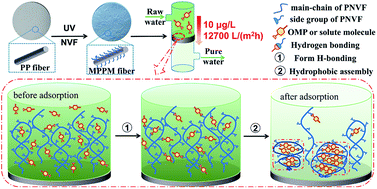Hydrogen bonding-induced hydrophobic assembly yields strong affinity of an adsorptive membrane for ultrafast removal of trace organic micropollutants from water†
Abstract
The high-efficiency and rapid removal of trace organic micropollutants (OMPs) is vital to ensure the safety of drinking water. It remains a huge challenge for conventional materials because of their weak affinity for trace OMPs. Here, a new class of adsorptive membranes (MPPMs) with ultrastrong affinity is prepared and could effectively capture a broad range of trace OMPs (10 μg L−1) in flow-through mode. The unique adsorption and regeneration performance of the MPPM surpass those of typical commercial membranes. Even at an ultrahigh water flux (12 700 L (m−2 h−1)), the MPPM is able to reduce OMP molecules in water samples by up to 2–3 orders of magnitude, showing great potential in fast production of high quality water and remediation of water resources. The adsorption mechanism is revealed using variable-temperature FTIR, pyrene fluorescence, and two-dimensional nuclear Overhauser effect spectroscopy (2D-NOESY), and simulation. These results indicate that the ultrastrong affinity is yielded by the synergy between hydrogen bonding and the hydrophobic interaction and this synergy is achieved through a mechanism called hydrogen bonding-induced hydrophobic assembly. In addition, the membrane could concentrate organic solutes in the aqueous phase up to 150 times through an adsorption–elution mode. Thus, the strategy may open a pathway to design adsorptive membranes for the capture of trace OMPs from water and adsorptive materials for solid phase extraction.



 Please wait while we load your content...
Please wait while we load your content...